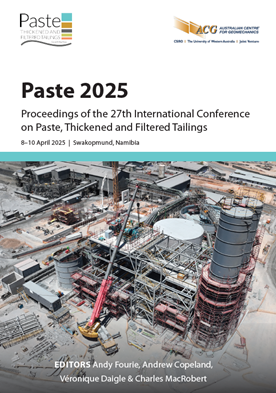On the importance of transient seepage modelling in setting piezometer trigger action response plans

|
Authors: McPhail, GI; Ugaz, R; Zea, A; Meza, O |
DOI https://doi.org/10.36487/ACG_repo/2555_48
Cite As:
McPhail, GI, Ugaz, R, Zea, A & Meza, O 2025, 'On the importance of transient seepage modelling in setting piezometer trigger action response plans', in AB Fourie, A Copeland, V Daigle & C MacRobert (eds), Paste 2025: Proceedings of the 27th International Conference on Paste, Thickened and Filtered Tailings, Australian Centre for Geomechanics, Perth, pp. 673-682, https://doi.org/10.36487/ACG_repo/2555_48
Abstract:
Trigger action response plans, or critical controls, form an important mechanism for checking on the status and performance of tailings storage facilities. Critical controls can be set for pond size, pond location, movement monitoring, drain flow rates and, most commonly, piezometer pressures. The process for establishing piezometer pressure critical controls usually entails conducting slope stability modelling and establishing the piezometer pressures at which Factor of Safety (FOS) values of 1.5, 1.3 or 1 against slope instability are predicted. Frequently the method of establishing the piezometer pressures entails setting up the slope with a phreatic surface estimated from existing piezometer readings and then progressively elevating the phreatic surface until the relevant FOS values are predicted. The pressures associated with each phreatic surface are tabulated to form the piezometer pressure critical controls. This approach does not, however, correlate causes of rises in piezometer pressures against the measured pressures, complicating the interpretation of situations where one or two piezometers exceed their critical controls in a section while the remaining piezometers show pressures well below their assigned critical controls. A more thorough approach entails calibration of transient seepage models against historical piezometer pressure measurements followed by application of the seepage model to evaluate the impact of upset conditions such as a pond against the embankment or malfunction of the underdrainage system, thereby linking cause and effect. This paper describes this approach and shows, through examples, its practical benefits in ensuring that monitoring against critical controls is not simply trigger-focused but also provides insight to the cause of a rise in piezometer pressure above its assigned control level.
Keywords: TARPs, critical controls, slope stability, transient seepage modelling
References:
International Council on Mining and Metals 2020, Global Industry Standard on Tailings Management, London.
© Copyright 2025, Australian Centre for Geomechanics (ACG), The University of Western Australia. All rights reserved.
View copyright/legal information
Please direct any queries or error reports to repository-acg@uwa.edu.au
View copyright/legal information
Please direct any queries or error reports to repository-acg@uwa.edu.au
